The Impact of Nanoparticles Due to Applied Magnetic Dipole in Micropolar Fluid Flow Using the Finite Element Method
Abstract
:1. Introduction
2. Problem Description
3. Implementation of Method
3.1. Variational Formulations
3.2. Finite Element Formulation
4. Results and Discussion
5. Concluding Remarks
- With increasing values of thermal stratification corresponds in decreasing of velocity and temperature profiles, Further, the heat transfer rate increases by increasing values of parameter .
- The velocity, temperature, and micro-rotational velocity is higher in the micropolar ferromagnetic fluid as compare to the ferrimagnetic fluid.
- Thermal conduction of nanoparticles enhances with the inconsistency of volume fraction.
- The effect of K on the velocity profile and the micro-rotational velocity is increasing whereas it is declining in the thermal boundary layer.
- The velocity profile reduces with increasing values of suction/injection parameter and ferromagnetic parameter in the presence of magnetic dipole while the temperature field increases.
- The velocity profile is a decreasing function of slip parameter while also an increasing function of temperature profile and relative boundary layer of nanofluids.
- In the presence of magnetic dipole reducing the rate of heat transfer has been perceived.
Author Contributions
Funding
Acknowledgments
Conflicts of Interest
Nomenclature
| Local Reynold number | |
| Thermal radiation parameter | |
| Thermal Stratification | |
| Normal anxiety moduli | |
| Fluid density | |
| Viscosity of fluid | |
| pyromagnetic coefficient | |
| M | Magnetic penetrability |
| Magnetic field | |
| Thermal capability of nano-fluid | |
| Spin gradient viscosity | |
| Rosseland eradicative heat flux | |
| Stefan-Boltzmann number | |
| Mean assimilation coefficient | |
| Curie temperature | |
| T | Non-dimensional temperature |
| Temperature at surface | |
| Temperature away from the surface | |
| m | Micro-rotation parameter |
| Velocity of sheet | |
| Velocity components | |
| Ferromagnetic parameter | |
| Viscous dissipation | |
| Normal anxiety moduli | |
| Prandtl number | |
| boundary parameter | |
| Slip parameter | |
| K | micro-rotation parameter |
| Solid volume fraction | |
| thermal conductivity of nanoparticles | |
| thermal conductivity of base fluid | |
| density of the nanoparticles | |
| density of base fluid | |
| Strength of magnetic field |
References
- Esfe, M.H.; Saedodin, S.; Akbari, M.; Karimipour, A.; Afrand, M.; Wongwises, S.; Safaei, M.R.; Dahari, M. Experimental investigation and development of new correlations for thermal conductivity of CuO/EG–water nanofluid. Int. Commun. Heat Mass Transf. 2015, 65, 47–51. [Google Scholar] [CrossRef]
- Keblinski, P.; Prasher, R.; Eapen, J. Thermal conductance of nanofluids: Is the controversy over? J. Nanoparticle Res. 2008, 10, 1089–1097. [Google Scholar] [CrossRef]
- Godson, L.; Raja, B.; Lal, D.M.; Wongwises, S. Enhancement of heat transfer using nanofluids—An overview. Renew. Sustain. Energy Rev. 2010, 14, 629–641. [Google Scholar] [CrossRef]
- Akbar, N.S. Ferromagnetic CNT suspended H2O+Cu nanofluid analysis through composite stenosed arteries with permeable wall. Phys. E Low-Dimens. Syst. Nanostruct. 2015, 72, 70–76. [Google Scholar] [CrossRef]
- Frey, N.A.; Peng, S.; Cheng, K.; Sun, S. Magnetic nanoparticles: Synthesis, functionalization, and applications in bioimaging and magnetic energy storage. Chem. Soc. Rev. 2009, 38, 2532–2542. [Google Scholar] [CrossRef] [PubMed]
- Kami, D.; Takeda, S.; Itakura, Y.; Gojo, S.; Watanabe, M.; Toyoda, M. Application of magnetic nanoparticles to gene delivery. Int. J. Mol. Sci. 2011, 12, 3705–3722. [Google Scholar] [CrossRef] [PubMed] [Green Version]
- Crane, L.J. Flow past a stretching plate. Z. Angew. Math. Phys. ZAMP 1970, 21, 645–647. [Google Scholar] [CrossRef]
- Sarafraz, M.; Tlili, I.; Tian, Z.; Khan, A.R.; Safaei, M.R. Thermal analysis and thermo-hydraulic characteristics of zirconia–water nanofluid under a convective boiling regime. J. Therm. Anal. Calorim. 2020, 139, 2413–2422. [Google Scholar] [CrossRef]
- Odenbach, S. Ferrofluids: Magnetically Controllable Fluids and Their Applications; Springer: Berlin/Heidelberg, Germnay, 2008; Volume 594. [Google Scholar]
- Neuringer, J.L. Some viscous flows of a saturated ferro-fluid under the combined influence of thermal and magnetic field gradients. Int. J. Non-Linear Mech. 1966, 1, 123–137. [Google Scholar] [CrossRef]
- Sharma, A.; Sharma, D.; Sharma, R. Effect of dust particles on thermal convection in a ferromagnetic fluid. Z. Naturforschung A 2005, 60, 494–502. [Google Scholar]
- Mee, C. The mechanism of colloid agglomeration in the formation of Bitter patterns. Proc. Phys. Soc. Sect. A 1950, 63, 922. [Google Scholar] [CrossRef]
- Nadeem, S.; Raishad, I.; Muhammad, N.; Mustafa, M. Mathematical analysis of ferromagnetic fluid embedded in a porous medium. Results Phys. 2017, 7, 2361–2368. [Google Scholar] [CrossRef]
- Sheikholeslami, M. Numerical simulation of magnetic nanofluid natural convection in porous media. Phys. Lett. A 2017, 381, 494–503. [Google Scholar] [CrossRef]
- Madhu, M.; Kishan, N. Finite element analysis of heat and mass transfer by MHD mixed convection stagnation-point flow of a non-Newtonian power-law nanofluid towards a stretching surface with radiation. J. Egypt. Math. Soc. 2016, 24, 458–470. [Google Scholar] [CrossRef] [Green Version]
- Bognár, G.; Hriczó, K. Ferrofluid Flow in the Presence of Magnetic Dipole. Tech. Mech. 2019, 39, 3–15. [Google Scholar]
- Ali, B.; Yu, X.; Sadiq, M.T.; Rehman, A.U.; Ali, L. A Finite Element Simulation of the Active and Passive Controls of the MHD Effect on an Axisymmetric Nanofluid Flow with Thermo-Diffusion over a Radially Stretched Sheet. Processes 2020, 8, 207. [Google Scholar] [CrossRef] [Green Version]
- Li, Q.; Xuan, Y.; Wang, J. Experimental investigations on transport properties of magnetic fluids. Exp. Therm. Fluid Sci. 2005, 30, 109–116. [Google Scholar] [CrossRef]
- Ali, L.; Liu, X.; Ali, B.; Mujeed, S.; Abdal, S.; Khan, S.A. Analysis of Magnetic Properties of Nano-Particles Due to a Magnetic Dipole in Micropolar Fluid Flow over a Stretching Sheet. Coatings 2020, 10, 170. [Google Scholar] [CrossRef] [Green Version]
- Yirga, Y.; Tesfay, D. Heat and mass transfer in MHD flow of nanofluids through a porous media due to a permeable stretching sheet with viscous dissipation and chemical reaction effects. Int. J. Mech. Aerospace Ind. Mech. Manuf. Eng. 2015, 9, 674–681. [Google Scholar]
- Nadeem, S.; Muhammad, N. Impact of stratification and Cattaneo-Christov heat flux in the flow saturated with porous medium. J. Mol. Liquids 2016, 224, 423–430. [Google Scholar] [CrossRef]
- Muhammad, N.; Nadeem, S.; Haq, R.U. Heat transport phenomenon in the ferromagnetic fluid over a stretching sheet with thermal stratification. Results Phys. 2017, 7, 854–861. [Google Scholar] [CrossRef]
- Ali, L.; Liu, X.; Ali, B.; Mujeed, S.; Abdal, S. Finite Element Simulation of Multi-Slip Effects on Unsteady MHD Bioconvective Micropolar nanofluid Flow Over a Sheet with Solutal and Thermal Convective Boundary Conditions. Coatings 2019, 9, 842. [Google Scholar] [CrossRef]
- Khan, S.A.; Nie, Y.; Ali, B. Multiple slip effects on MHD unsteady viscoelastic nano-fluid flow over a permeable stretching sheet with radiation using the finite element method. SN Appl. Sci. 2020, 2, 66. [Google Scholar] [CrossRef] [Green Version]
- Turkyilmazoglu, M. Flow of a micropolar fluid due to a porous stretching sheet and heat transfer. Int. J. Non-Linear Mech. 2016, 83, 59–64. [Google Scholar] [CrossRef]
- Shadloo, M.; Kimiaeifar, A.; Bagheri, D. Series solution for heat transfer of continuous stretching sheet immersed in a micropolar fluid in the existence of radiation. Int. J. Numer. Methods Heat Fluid Flow 2013, 23, 289–304. [Google Scholar] [CrossRef]
- Pradhan, S.; Baag, S.; Mishra, S.; Acharya, M. Free convective MHD micropolar fluid flow with thermal radiation and radiation absorption: A numerical study. Heat Transf. Asian Res. 2019, 48, 2613–2628. [Google Scholar] [CrossRef]
- Bahiraei, M.; Mazaheri, N.; Aliee, F.; Safaei, M.R. Thermo-hydraulic performance of a biological nanofluid containing graphene nanoplatelets within a tube enhanced with rotating twisted tape. Powder Technol. 2019, 355, 278–288. [Google Scholar] [CrossRef]
- Eringen, A.C. Theory of micropolar fluids. J. Math. Mech. 1966, 16, 1–18. [Google Scholar] [CrossRef]
- Ahmadi, G. Self-similar solution of imcompressible micropolar boundary layer flow over a semi-infinite plate. Int. J. Eng. Sci. 1976, 14, 639–646. [Google Scholar] [CrossRef]
- Gorla, R.S.R. Micropolar boundary layer flow at a stagnation point on a moving wall. Int. J. Eng. Sci. 1983, 21, 25–33. [Google Scholar] [CrossRef]
- Ibrahim, W.; Shankar, B. MHD boundary layer flow and heat transfer of a nanofluid past a permeable stretching sheet with velocity, thermal and solutal slip boundary conditions. Comput. Fluids 2013, 75, 1–10. [Google Scholar] [CrossRef]
- Das, K. Slip flow and convective heat transfer of nanofluids over a permeable stretching surface. Comput. Fluids 2012, 64, 34–42. [Google Scholar] [CrossRef]
- Abbas, Z.; Wang, Y.; Hayat, T.; Oberlack, M. Slip effects and heat transfer analysis in a viscous fluid over an oscillatory stretching surface. Int. J. Numer. Methods Fluids 2009, 59, 443–458. [Google Scholar] [CrossRef]
- Abdal, S.; Ali, B.; Younas, S.; Ali, L.; Mariam, A. Thermo-Diffusion and Multislip Effects on MHD Mixed Convection Unsteady Flow of Micropolar Nanofluid over a Shrinking/Stretching Sheet with Radiation in the Presence of Heat Source. Symmetry 2020, 12, 49. [Google Scholar] [CrossRef] [Green Version]
- Titus, L.; Abraham, A. Ferromagnetic Liquid Flow due to Gravity-Aligned Stretching of an Elastic Sheet. J. Appl. Fluid Mech. 2015, 8, 591–600. [Google Scholar] [CrossRef]
- Tiwari, R.K.; Das, M.K. Heat transfer augmentation in a two-sided lid-driven differentially heated square cavity utilizing nanofluids. Int. J. Heat Mass Transf. 2007, 50, 2002–2018. [Google Scholar] [CrossRef]
- Andersson, H.; Valnes, O. Flow of a heated ferrofluid over a stretching sheet in the presence of a magnetic dipole. Acta Mech. 1998, 128, 39–47. [Google Scholar] [CrossRef]
- Palaniappan, B.; Ramasamy, V. Thermodynamic analysis of fly ash nanofluid for automobile (heavy vehicle) radiators. J. Therm. Anal. Calorim. 2019, 136, 223–233. [Google Scholar] [CrossRef]
- Domkundwar, A.; Domkundwar, V. Heat and Mass Transfer Data Book; Dhanpat Rai: New Delhi, India, 2007. [Google Scholar]
- Ali, B.; Naqvi, R.A.; Nie, Y.; Khan, S.A.; Sadiq, M.T.; Rehman, A.U.; Abdal, S. Variable Viscosity Effects on Unsteady MHD an Axisymmetric Nanofluid Flow over a Stretching Surface with Thermo-Diffusion: FEM Approach. Symmetry 2020, 12, 234. [Google Scholar] [CrossRef] [Green Version]
- Gupta, D.; Kumar, L.; Bég, O.A.; Singh, B. Finite element analysis of MHD flow of micropolar fluid over a shrinking sheet with a convective surface boundary condition. J. Eng. Thermophys. 2018, 27, 202–220. [Google Scholar] [CrossRef]
- Bhargava, R.; Rana, P. Finite element solution to mixed convection in MHD flow of micropolar fluid along a moving vertical cylinder with variable conductivity. Int. J. Appl. Math. Mech. 2011, 7, 29–51. [Google Scholar]
- Khan, S.A.; Nie, Y.; Ali, B. Stratification and Buoyancy Effect of Heat Transportation in Magnetohydrodynamics Micropolar Fluid Flow Passing over a Porous Shrinking Sheet Using the Finite Element Method. J. Nanofluids 2019, 8, 1640–1647. [Google Scholar] [CrossRef]
- Reddy, J.N. Solutions Manual for an Introduction to the Finite Element Method; McGraw-Hill: New York, NY, USA, 1993; Volume 27, p. 41. [Google Scholar]
- Swapna, G.; Kumar, L.; Rana, P.; Singh, B. Finite element modeling of a double-diffusive mixed convection flow of a chemically-reacting magneto-micropolar fluid with convective boundary condition. J. Taiwan Inst. Chem. Eng. 2015, 47, 18–27. [Google Scholar] [CrossRef]
- Gupta, D.; Kumar, L.; Beg, O.A.; Singh, B. Finite-element analysis of transient heat and mass transfer in microstructural boundary layer flow from a porous stretching sheet. Comput. Therm. Sci. Int. J. 2014, 6, 155–169. [Google Scholar] [CrossRef]
- Ali, L.; Liu, X.; Ali, B.; Mujeed, S.; Abdal, S. Finite Element Analysis of Thermo-Diffusion and Multi-Slip Effects on MHD Unsteady Flow of Casson Nano-Fluid over a Shrinking/Stretching Sheet with Radiation and Heat Source. Appl. Sci. 2019, 9, 5217. [Google Scholar] [CrossRef] [Green Version]
- Ali, B.; Nie, Y.; Khan, S.A.; Sadiq, M.T.; Tariq, M. Finite Element Simulation of Multiple Slip Effects on MHD Unsteady Maxwell Nanofluid Flow over a Permeable Stretching Sheet with Radiation and Thermo-Diffusion in the Presence of Chemical Reaction. Processes 2019, 7, 628. [Google Scholar] [CrossRef] [Green Version]
- Majeed, A.; Zeeshan, A.; Ellahi, R. Unsteady ferromagnetic liquid flow and heat transfer analysis over a stretching sheet with the effect of dipole and prescribed heat flux. J. Mol. Liq. 2016, 223, 528–533. [Google Scholar] [CrossRef]
- Bachok, N.; Ishak, A.; Nazar, R. Flow and heat transfer over an unsteady stretching sheet in a micropolar fluid. Meccanica 2011, 46, 935–942. [Google Scholar] [CrossRef]
- Qasim, M.; Khan, I.; Shafie, S. Heat transfer in a micropolar fluid over a stretching sheet with Newtonian heating. PLoS ONE 2013, 8, e59393. [Google Scholar] [CrossRef] [Green Version]
- Hussanan, A.; Salleh, M.Z.; Khan, I. Microstructure and inertial characteristics of a magnetite ferrofluid over a stretching/shrinking sheet using effective thermal conductivity model. J. Mol. Liq. 2018, 255, 64–75. [Google Scholar] [CrossRef]
- Kumar, L. Finite element analysis of combined heat and mass transfer in hydromagnetic micropolar flow along a stretching sheet. Comput. Mater. Sci. 2009, 46, 841–848. [Google Scholar] [CrossRef]
- Muhammad, N.; Nadeem, S.; Mustafa, M. Analysis of ferrite nanoparticles in the flow of ferromagnetic nanofluid. PLoS ONE 2018, 13, e0188460. [Google Scholar] [CrossRef] [PubMed] [Green Version]
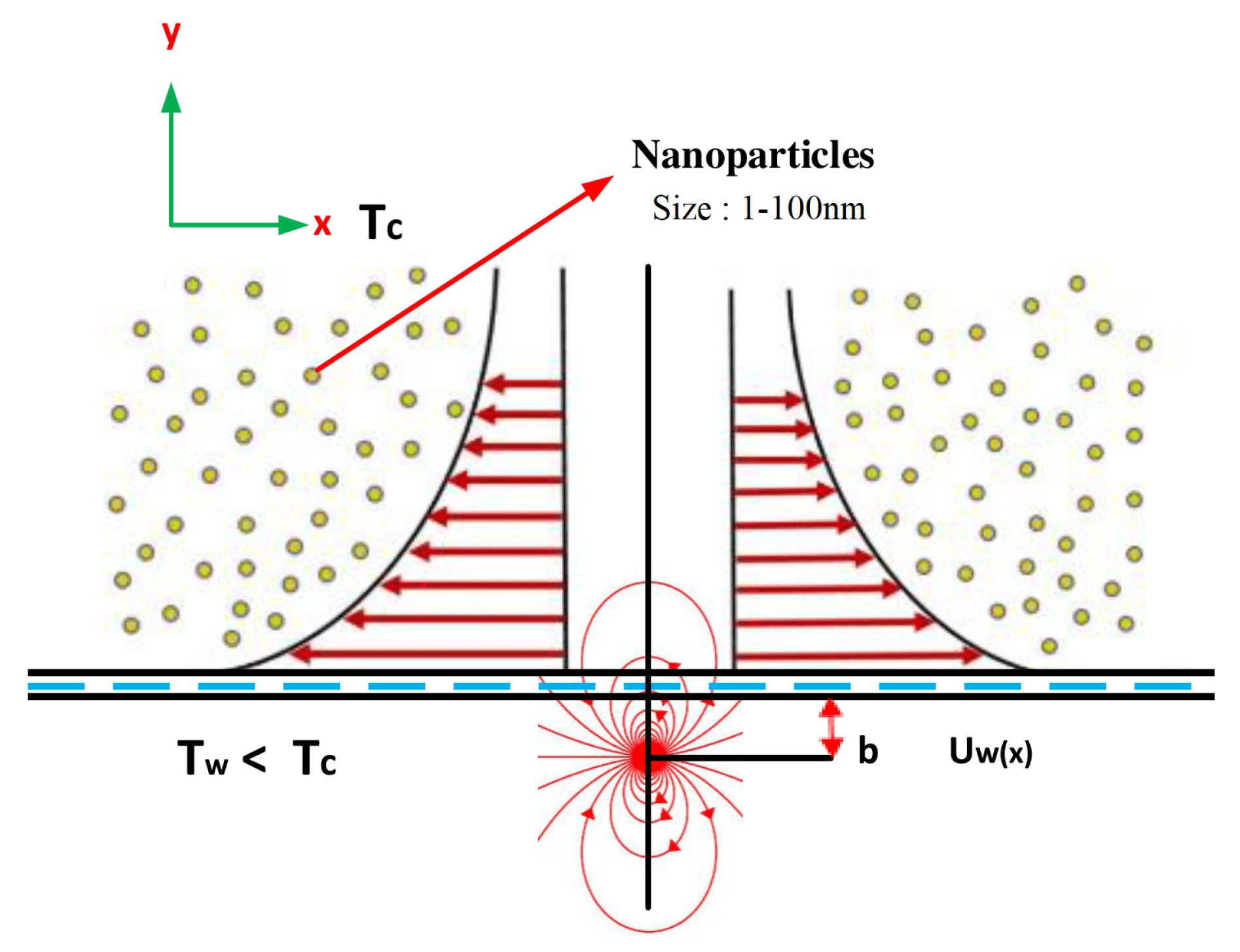



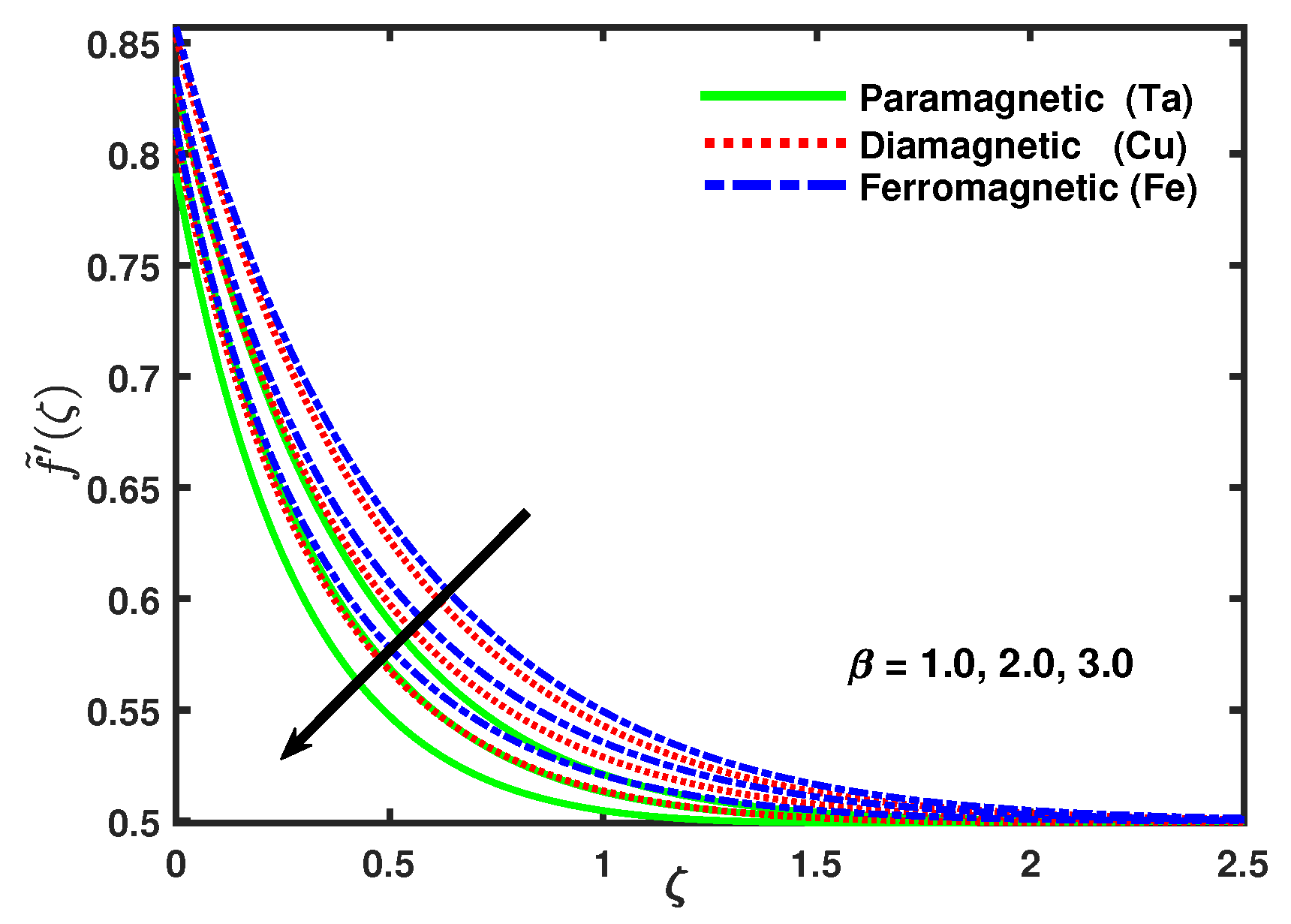
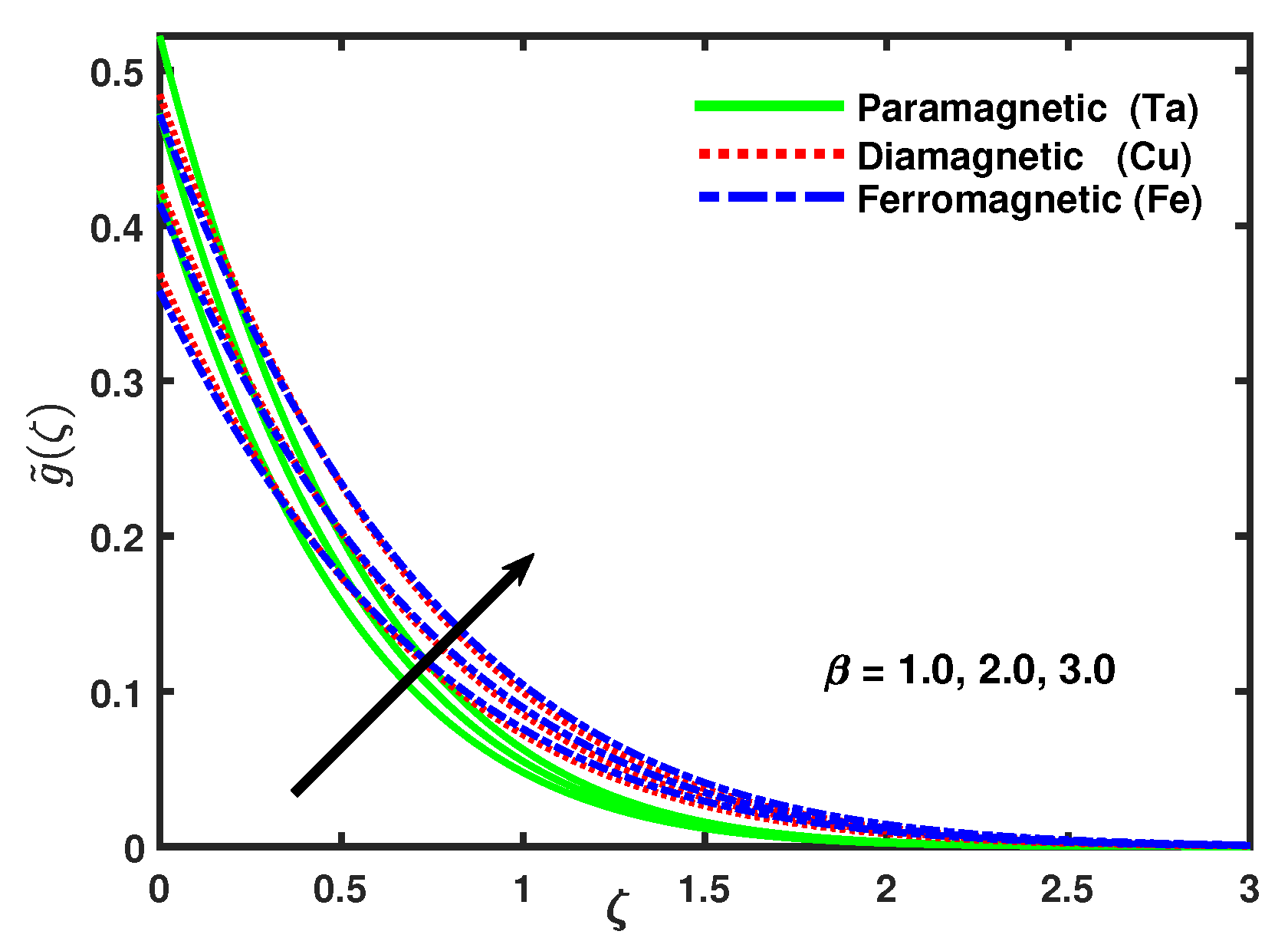
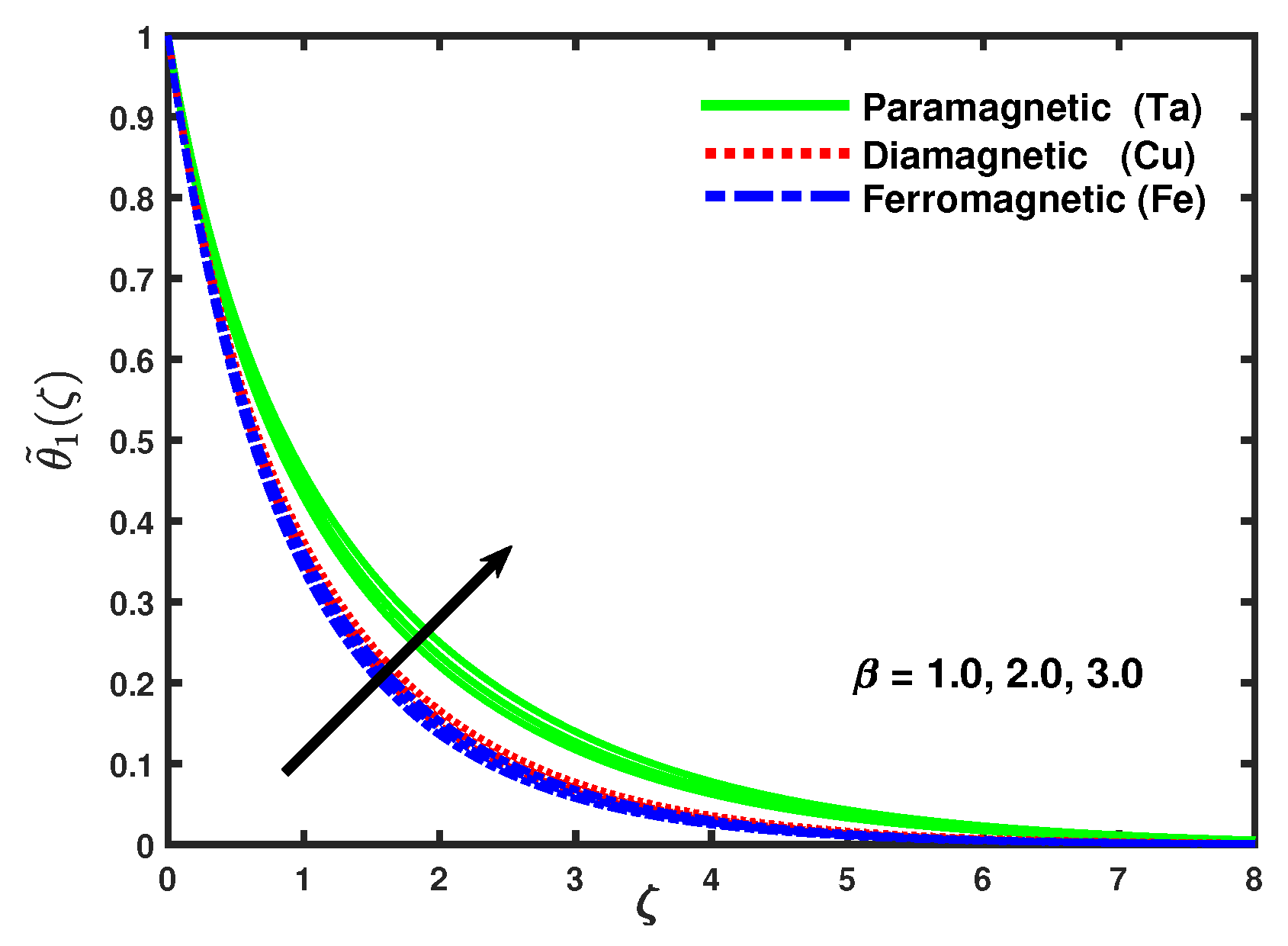



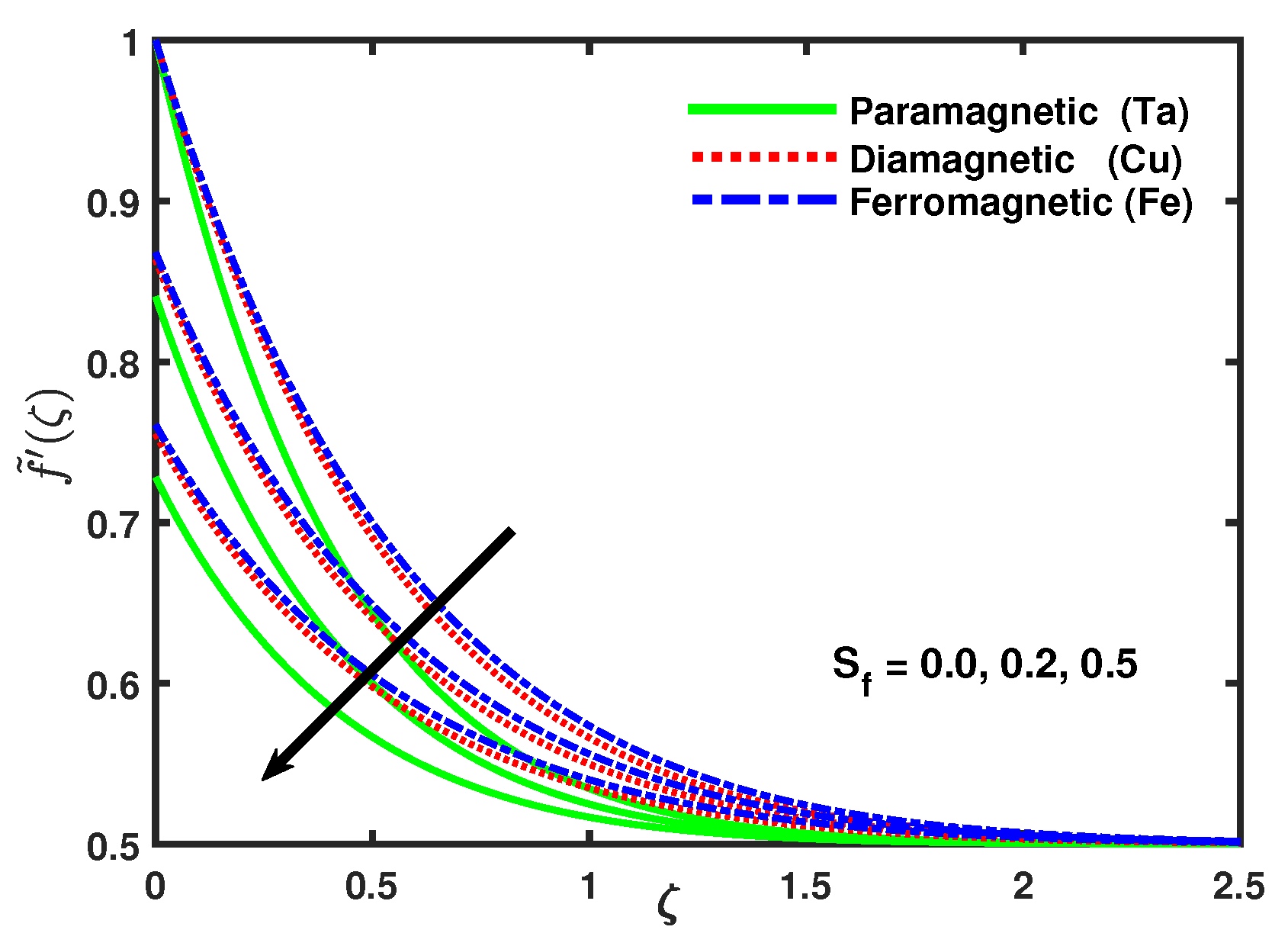
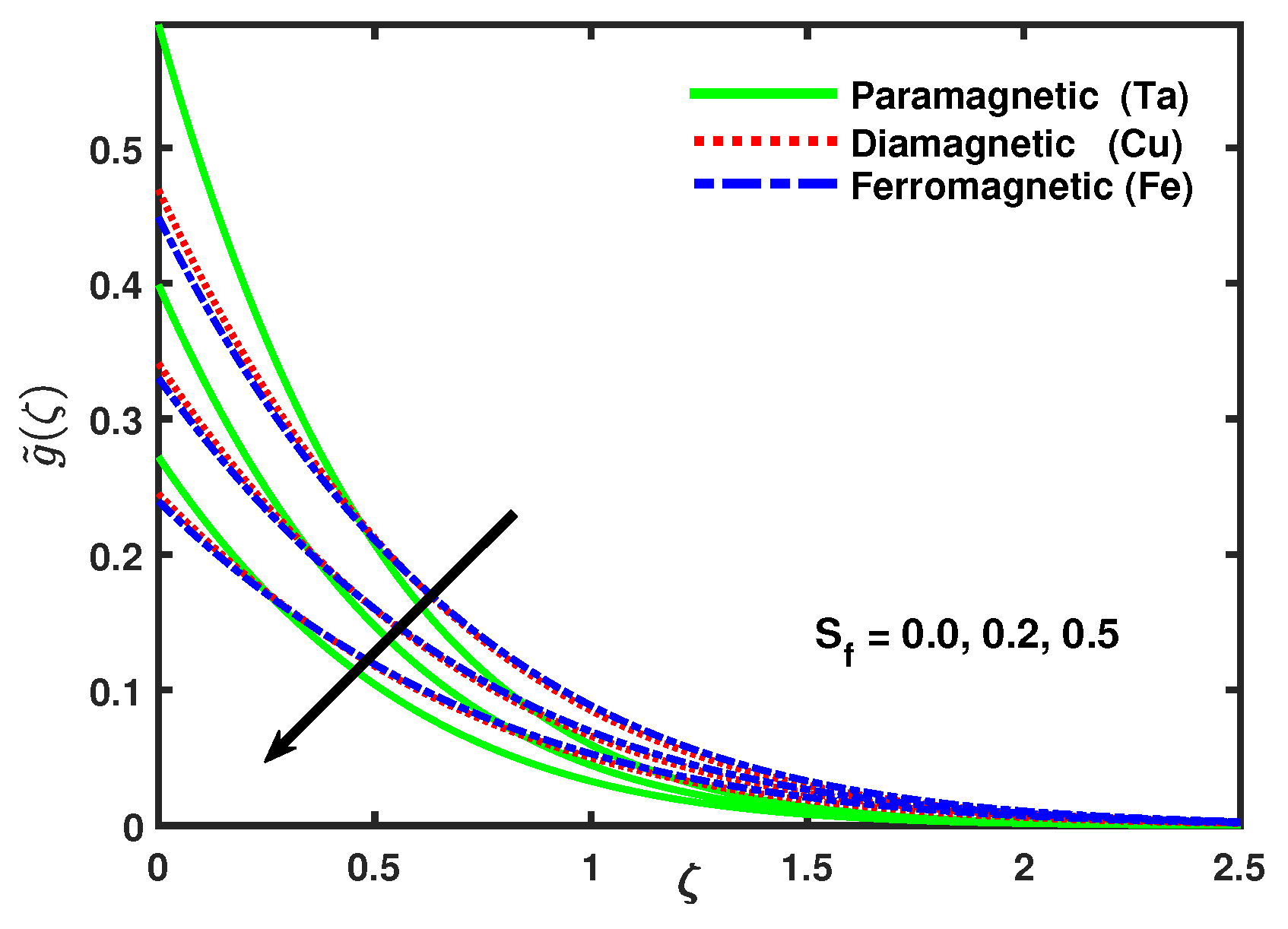
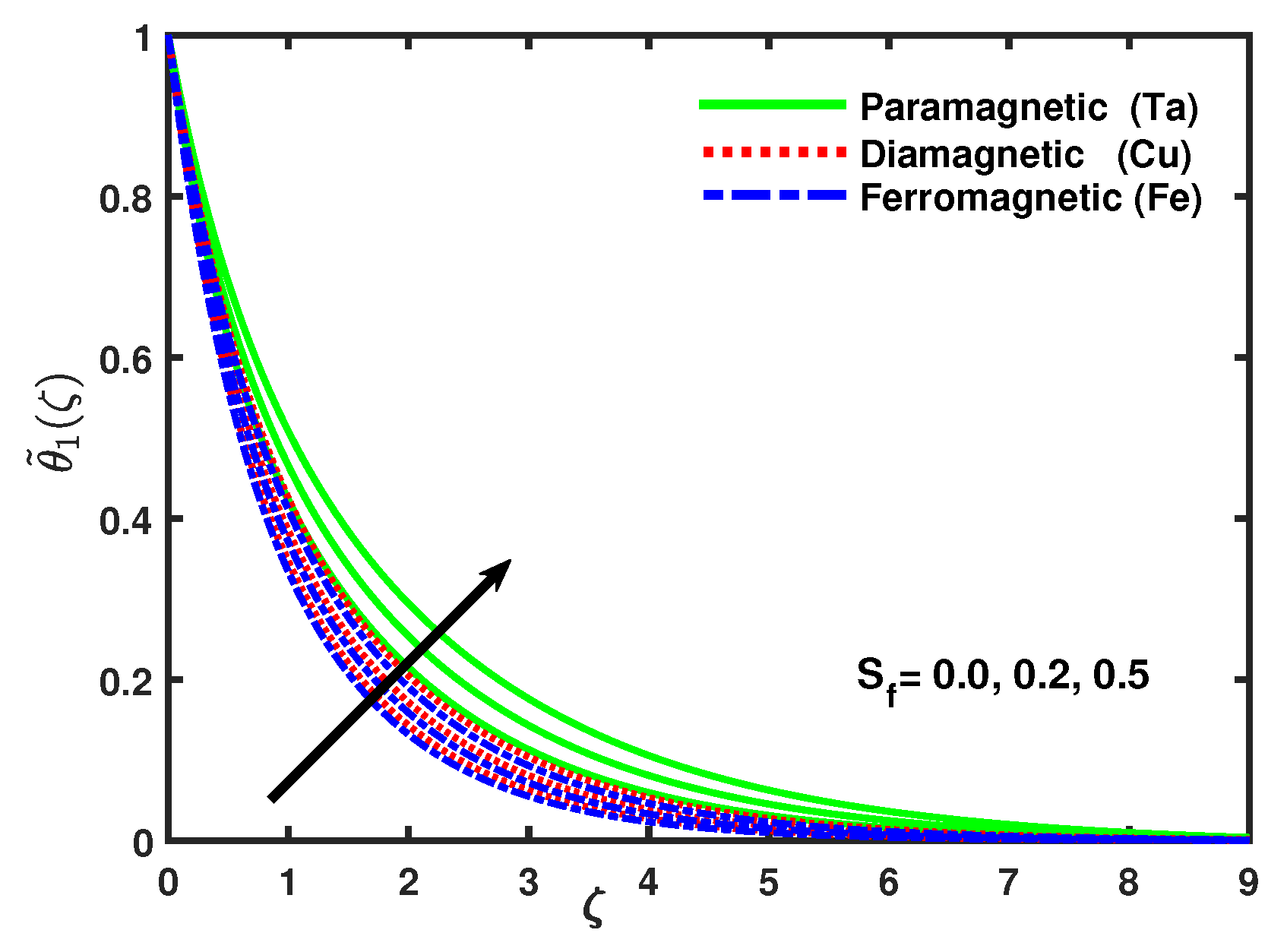

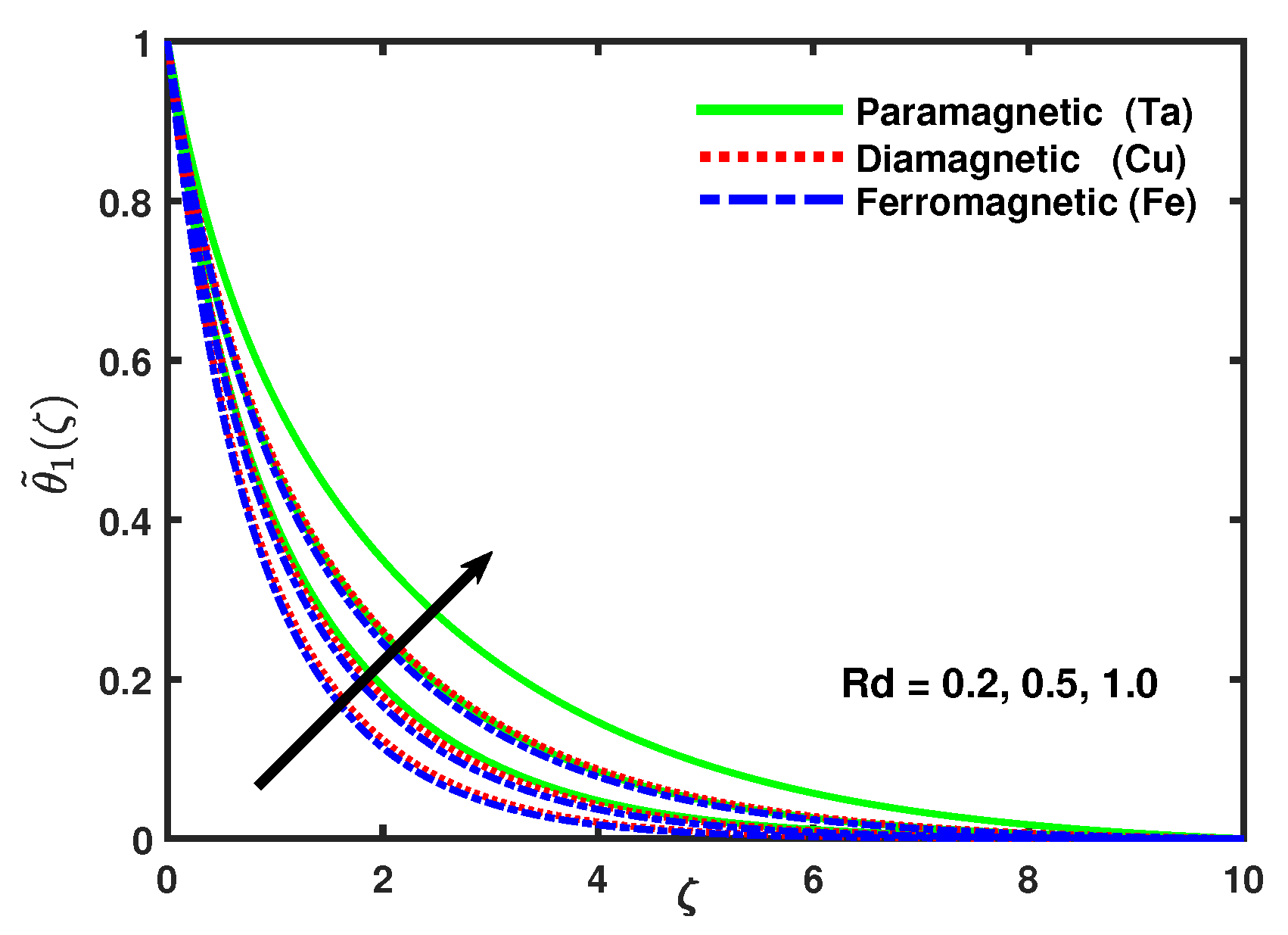


| Property | Base Fluid [39] | Paramagnetic (Ta) [40] | Diamagnetic (Cu) [40] | Ferromagnetic (Fe) [40] |
|---|---|---|---|---|
| ·· | 3752 | 140 | 385 | 447 |
| · | 1054 | 16,600 | 8933 | 7870 |
| ·· | 0.416 | 57.5 | 401 | 80.2 |
| Number of Elements | ||||
|---|---|---|---|---|
| 40 | 0.007067 | 0.006707 | 0.143487 | 0.000010 |
| 100 | 0.007279 | 0.006842 | 0.142996 | 0.000011 |
| 200 | 0.007309 | 0.006861 | 0.142925 | 0.000012 |
| 340 | 0.007315 | 0.006865 | 0.142909 | 0.000012 |
| 500 | 0.007317 | 0.006866 | 0.142905 | 0.000012 |
| 700 | 0.007318 | 0.006867 | 0.142903 | 0.000012 |
| Pr | Sohaib et al. [35] | Liaqat et al. [48] | Bagh et al. [49] | Majeed et al. [50] | Bachok et al. [51] | FEM (Current Results) |
|---|---|---|---|---|---|---|
| 0.72 | 0.808633 | 0.808634 | 0.808634 | 0.808640 | 0.8086 | 0.808633 |
| 1.00 | 1.000008 | 1.000001 | 1.000001 | 1.000000 | 1.0000 | 1.000009 |
| 3.00 | 1.923677 | 1.923678 | 1.923683 | 1.923609 | 1.9237 | 1.923680 |
| 10.0 | 3.720668 | 3.720668 | 3.720674 | 3.720580 | 3.7207 | 3.720669 |
| K | Qasim et al. [52] | Abid Hussanan et al. [53] | Kumar [54] | FEM (Current Results) | |
|---|---|---|---|---|---|
| 0.0 | 0.5 | −1.000000 | −1.0000000 | - | −1.0000089 |
| 1.0 | −1.224741 | −1.2247448 | - | −1.2248199 | |
| 2.0 | −1.414218 | −1.4142135 | - | −1.4144797 | |
| 4.0 | −1.732052 | −1.7320508 | - | −1.7332924 | |
| 0.0 | 0.0 | −1.000000 | - | −1.000008 | −1.0000089 |
| 1.0 | −1.367872 | - | −1.367996 | −1.3679971 | |
| 2.0 | −1.621225 | - | −1.621575 | −1.6215754 | |
| 4.0 | −2.004133 | - | −2.005420 | −2.0054211 |
© 2020 by the authors. Licensee MDPI, Basel, Switzerland. This article is an open access article distributed under the terms and conditions of the Creative Commons Attribution (CC BY) license (http://creativecommons.org/licenses/by/4.0/).
Share and Cite
Ali, L.; Liu, X.; Ali, B.; Mujeed, S.; Abdal, S.; Mutahir, A. The Impact of Nanoparticles Due to Applied Magnetic Dipole in Micropolar Fluid Flow Using the Finite Element Method. Symmetry 2020, 12, 520. https://doi.org/10.3390/sym12040520
Ali L, Liu X, Ali B, Mujeed S, Abdal S, Mutahir A. The Impact of Nanoparticles Due to Applied Magnetic Dipole in Micropolar Fluid Flow Using the Finite Element Method. Symmetry. 2020; 12(4):520. https://doi.org/10.3390/sym12040520
Chicago/Turabian StyleAli, Liaqat, Xiaomin Liu, Bagh Ali, Saima Mujeed, Sohaib Abdal, and Ali Mutahir. 2020. "The Impact of Nanoparticles Due to Applied Magnetic Dipole in Micropolar Fluid Flow Using the Finite Element Method" Symmetry 12, no. 4: 520. https://doi.org/10.3390/sym12040520








